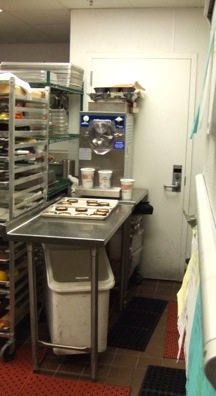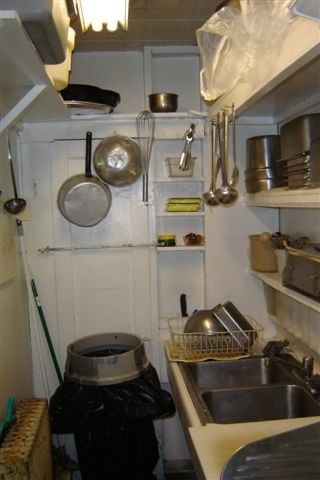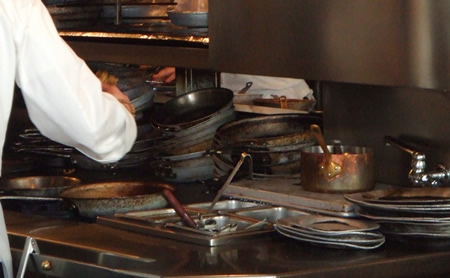Pots and pans clang, exhaust hoods drone on and on, chefs shout at waiters, sommeliers hustle about with grand vin du bordeaux and more, and through it all, the kitchen is always the heart of a restaurant.
When you spend all of your time in the kitchen, or even when you’re just passing through one a hundred times each day, do you ever stop to think: Somebody had to draw this? In all but the lowest common denominator restaurants out there, and even in the case of a few of those…the kitchen was designed by somebody. What’s the difference between a kitchen that’s merely designed and one that’s well-designed? The short answer: Everything.
The professional kitchen is not a simple game of Boggle where you take all the bits and pieces of equipment, place them in a box, shake it up, and then try and invent effective work stations out of the results. In 10+ years spent cooking in a range of restaurants, from delis and Chinese take out spots to luxury hotels and fine-dining destination eateries on both American coasts and abroad, I’ve worked in more than a few of those painful things. I have also been fortunate enough to work in a few gorgeous kitchens…well made, properly lit, and with the kinds of amenities that really mean something to a working cook like me. It’s good for my current business, but there are still quite a few clients out there who are requesting corrections to their own Scrabble-rack collections of equipment. FYI, Boggle Kitchens to Confound Your Brain is the title of my forthcoming book. (Okay, not really.)

But it’s easy to see how a kitchen can become that way, though…with any measurable lack of planning. It’s akin to setting up mise en place for a busy Saturday night, though in this case service can last a few years or more, and falling in the weeds can have devastating financial consequences to you, your employees, and your bottom line. Small missteps early on can lead to shortages, overages, miscalculations and all manner of other nefarious and unsavory results.
When restaurant construction and remodel jobs start lagging on schedules…owners and financiers start losing money, and that’s a heck of a lot more painful for all parties involved than simply getting hung out to dry by a sous chef because your Souffle aux Pommes fell before it got to the table. Trying to get restaurant kitchens planned and configured early in a project’s development is key to success, yet time and again we see the kitchen as an afterthought. The money has already been spent on window treatments, and the square footage has already been allotted elsewhere.

A poorly laid out kitchen contributes negatively in a wide array of ways, from simple things like food getting cold in the pass because waiters are held up at the dish table, to the more mundane and dangerous like cross-contamination and egregious violations of HACCP protocols. Because of poor working conditions and bad traffic patterns, you’ll also likely see a reduction in creativity and job satisfaction among chefs, the creation of safety hazards and slip-and-fall injuries for runners, waiters and stewards, and at the end of the day they just might cause your employees to resent you for making them all work in such a place.
There are many studies yet many disagreements about how exactly to properly design a working kitchen these days, but in my experience, the one thing most restaurant professionals agree on is that a well planned kitchen can be the core of your business, and a poorly done version can drown you in frustration if not in outright failure.
Say you have a wine-bar with tapas, or maybe a cafe that focuses on sweets. This other owner has a hodge-podge of globally inspired vegan sautees with produce from their own on-site farm yet someone else wants a row of tandoors for their Indian flavored commissary operation, and still there’s always that client that absolutely HAS to have an open kitchen in their upper-echelon dining room. They all have different equipment requirements, also different plumbing and electrical requirements obviously, but different staffing needs too and wildly varying storage needs.
What’s the commonality? Does a French restaurant need a deep fryer? Does a café need a salamander? What they really all need is a well thought out design that incorporates not just the basic tenets of food safety and HACCP, but also considers adjacency planning and takes into account who does what in each location. Each of those operations may cook and serve food to paying customers, but beyind that, they’re all pretty distinctive.
The potwasher still washes pots, sure, but might need a differently sized or configured sink to do his job well in each place. The whole nuts and bolts of how each restaurant works from the inside-out might just be more dissimilar than it is alike. In my line of work, the challenge of course is that unless my client is in the In-N-Out burger system (thank you Animal Style!) then no two hospitality projects are alike. As the designer, owner and operator, you need to think like the dishwasher, the waiter, the hearth cook, the saute guy and the vegetable cook if you’re going to make that place hum with profit. Ideally, you’re also thinking like the Health Inspector, the Plumber, the Hood Technician and the Laundry delivery dude…because the kitchen handles all of them. If that means hiring a kitchen designer in the process, well…what can I say. We do what we do for a reason.

One other primary concern that in my estimation is often overlooked: The life of my fellow cooks. I’m still, at the end of the day, a line cook at heart. For all the kitchen planning and design that I do, and for all the general restaurant and foodservice advice that I give…I care first and foremost for the cooks. I have the utmost respect of course for waiters, sommeliers and everyone else who spends their days and nights grinding out a living in the restaurant business, but my sole political motivation here is to help get cooks elevated in comfort if not in salary. Cooks have historically been at the bottom end of the pay-scale while at the high-end of hours worked. Additionally, cooks deal with the sharp things and the hot things more than anyone else, and that’s gotta count for something.
So, there you have it. Enough said for now, there’s plenty more where that came from…so next time, the Top 10 Kitchen Design Mistakes for you to avoid in your next project.